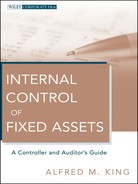APPENDIX
Excerpt of Internal Revenue Service Cost Segregation Audit Guide
SHOWN HERE IS A small section from the Internal Revenue Service’s (IRS’s) Audit Guide on Cost Segregation.
INTRODUCTION
Cost segregation studies are conducted for a variety of reasons (e.g., income tax, financial accounting, insurance purposes, property tax). For income tax purposes, a cost segregation study involves the allocation (or reallocation) of the total cost (or value) of property into the appropriate property classes in order to compute depreciation deductions. The results of a study are typically summarized in an accompanying report, although there is no standard format for either the study or the report.
The methodology utilized in allocating total project costs to various assets is critical to achieving an accurate cost segregation study. Some of the more common methodologies, and their potential drawbacks, are summarized in this chapter. This discussion should assist the examiner in evaluating the accuracy of a particular study and in performing a risk analysis with respect to the depreciation deductions based on that study.

WHAT ARE THE MOST COMMON METHODOLOGIES UTILIZED FOR COST SEGREGATION STUDIES?
Various methodologies are utilized in preparing cost segregation studies, including the following six:
1. Detailed Engineering Approach from Actual Cost Records
2. Detailed Engineering Cost Estimate Approach
3. Survey or Letter Approach
4. Residual Estimation Approach
5. Sampling or Modeling Approach
6. “Rule of Thumb” Approach
Examiners should not necessarily expect to see these terms mentioned in a study or in a report. Methodologies will also be described in varying detail in different reports. However, based on the information in this chapter, an examiner should be able to recognize the attributes of a given study and identify the methods or approaches used (and also identify the potential drawbacks). It should also be noted that other methodologies may be used, although most are merely derivatives of those enumerated above.

WHAT ARE THE ATTRIBUTES OF VARIOUS COST SEGREGATION METHODOLOGIES?
The following discussion takes a closer look at the main components and attributes of each of the methodologies listed above. Keep in mind that these are the steps normally taken in the preparation of a cost segregation study. The examiner’s responsibility is to review the steps taken and evaluate the accuracy of the study, as will be discussed in Chapter 5, “Review and Examination of Cost Segregation Studies.”

DETAILED ENGINEERING APPROACH FROM ACTUAL COST RECORDS
The detailed engineering approach from actual cost records, or “detailed cost approach,” uses costs from contemporaneous construction and accounting records. In general, it is the most methodical and accurate approach, relying on solid documentation and minimal estimation. Construction-based documentation, such as blueprints, specifications, contracts, job reports, change orders, payment requests, and invoices, are used to determine unit costs. The use of actual cost records contributes to the overall accuracy of cost allocations, although issues may still arise as to the classification of specific assets.
This approach is generally applied only to new construction, where detailed cost records are available. For used or acquired property and for new projects where original construction documents are not available, an alternative approach (e.g., the “detailed engineering cost estimate approach”) may be more appropriate.
The detailed cost approach typically includes the following ten activities:
1. Identify the specific project/assets that will be analyzed.
2. Obtain a complete listing of all project costs and substantiate the total project costs.
3. Inspect the facility to determine the nature of the project and its intended use.
4. Photograph specific property items for reference. Request previous site photographs that illustrate the construction progress as well as the condition of the property before the project began.
5. Review “as-built” blueprints, specifications, contracts, bid documents, contractor pay requests, and other construction documentation.
6. Identify and assign specific project items to property classes (e.g., land, land improvements, building, equipment, furniture and fixtures, and other items of tangible personal property).
7. Prepare quantitative “take-offs” for all materials and use payment records to compute unit costs.
8. Apply unit costs to each project component to determine its total cost. Reconcile total costs obtained from quantitative take-offs to total actual costs.
9. Allocate indirect costs, such as architectural fees, engineering fees, and permits, to appropriate assets.
10. Group project items with similar class lives and placed-in-service dates to compute depreciation.
The detailed cost approach is the most time-consuming method and generally provides the most accurate cost allocations. However, the examiner should recognize that the proper classification and costs of § 1245 property could still be an issue with this method.
..................Content has been hidden....................
You can't read the all page of ebook, please click here login for view all page.
